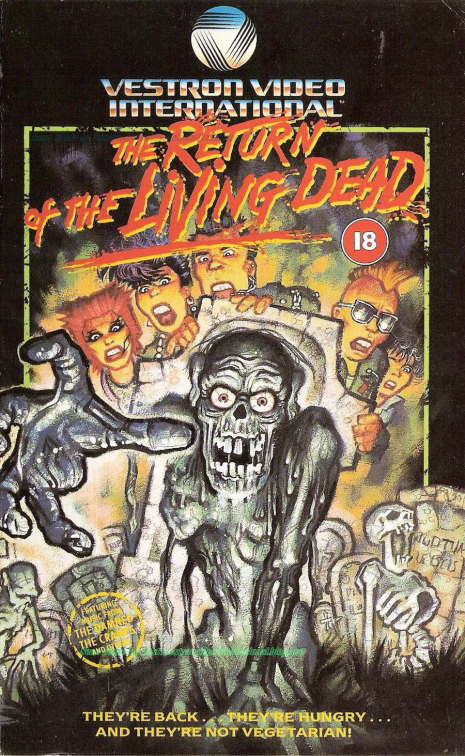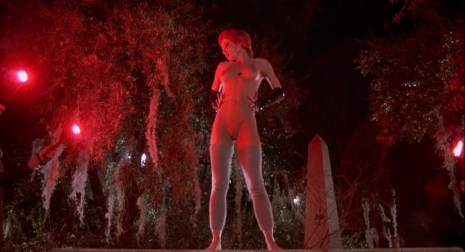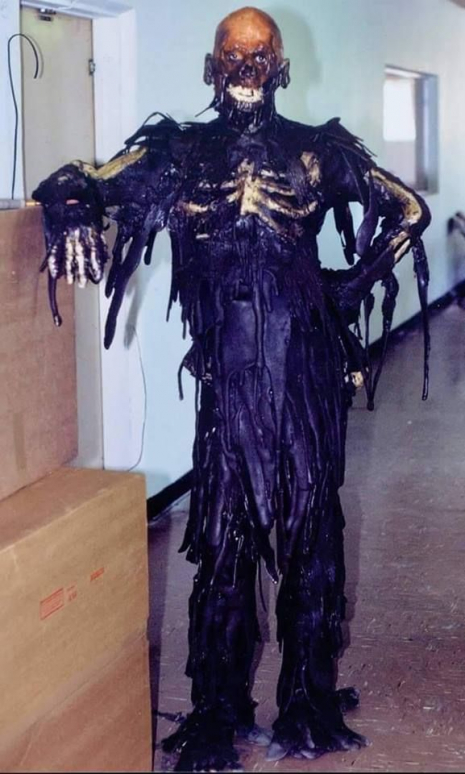
Artwork from Vestron Video and their UK VHS for ‘The Return of the Living Dead.’
Before we take a deep dive into the deviant classic that is 1985’s The Return of the Living Dead lets demystify the collection of films by late director George A. Romero and his partner John A. Russo. The first was Night of the Living Dead, released in 1968. Romero wrote the script for the film during his freshman year of college after meeting Russo while he was visiting Carnegie Tech in Pittsburgh where he was studying graphic arts. After passing the script back and forth, the pair finally agreed the zombie antagonists in their film would be of the flesh-eating variety, not primarily brain consumers. With respect to zombie film super fans, this distinction has often been lost on connoisseurs of the genre, and Romero himself has publicly lamented about being constantly asked to include the words “Eat Brains!” while signing autographs—even though his zombies were just not into eating human brains. Initially, the title of the film was “Night of the Flesh Eaters,’ which was later modified for its theatrical release in order to avoid confusion with the 1964 film, The Flesh Eaters. However the release lacked notation of copyright, errantly placing the film in public domain where by definition an artistic work is considered common property.
In 1974 Russo would pen his first novel based on Night of the Living Dead. Four years later would see the publication of Russo’s second book Return of the Living Dead, which served as the basis for his dark screenplay (written with another Romero collaborator, Rudy Ricci) and subsequent 1985 film adaptation of the book. According to an interview with Russo in 2018, none other than Frank Sinatra had agreed to finance the film but withdrew after his mother Dolly Sinatra was tragically killed in a plane crash. After it was clear George Romero wasn’t interested in directing, the late Tobe Hooper was tapped but pulled out to direct Lifeforce (1985). Eventually, Russo and Ricci’s original screenplay would end up with a man of many talents and connections, Dan O’Bannon (Heavy Metal, Alien, Total Recall and, coincidentally, one of the writers behind Lifeforce) who revamped it completely so much so Russo has said he’d still like to see his (and Ricci’s) original screenplay get the film treatment someday. Ultimately, this about-face wasn’t a bad thing at all, and at the urging of the film’s distributors, dialog and scenes were at times meant to be darkly humorous. The pioneering O’Bannon would end up in the director’s seat for the first of five Living Dead films, this being the only one directed by him. Thanks to many factors and concepts influenced or directly implemented by O’Bannon, the film would become one of the most beloved zombie flicks of all time.
Think I’m wrong? Let me help you with that starting with one of the film’s stars, actress and heavy metal fitness enthusiast Linnea Quigley, and the trick behind her long nude scene in the movie.

Actress Linnea Quigley as Trash getting ready to do her graveyard dance in the nude. Sort of.
Part of the plan for the release of the film was that it would also, at some point, be shown in an edited-for-TV form; devoid of most of its nudity and questionable language. At first, Quigley, who spends pretty much all of her time on camera nude, had pubic hair. The story goes, one of the film’s producers just so happened to be visiting the set while Quigley was doing her graveyard striptease and freaked out at the sight of her bush and ripped Dan O’Bannon personally, telling him that pubic hair could “not be shown on television.” The then 24-year-old Quigley was sent off for a quick Brazilian at the beauty parlor, which further horrified the producer (said to be line-producer Graham Henderson), who responded that you could now see Quigley’s “everything.” This guy. The job of disguising Quigley’s down-under parts would go to the film’s art department who created a mannequin-like prosthetic for Quigley’s hoo-hah, which made her lady parts look like a barbie’s plastic vulva. So for those of you of a certain generation which grew up believing you saw Linnea Quigley’s hairless crotch in The Return of the Living Dead, I’m sorry.
Another memorable and central-to-the-plot character was played by actor Don Calfa (who you might remember from another cult film, 1972’s Greaser’s Palace) in his role as Ernie, who runs the local mortuary. In the film, there are several times where O’Bannon drops hints about Ernie’s character, who according to his backstory is an escaped Nazi. Some of O’Bannon’s not so subtle clues include Calfa’s speaking in German and listening to German music about tanks “rolling in” on his headphones when he first appears on screen. An image of Hitler’s mistress Eva Braun hangs on the wall of the morgue, and another of Hitler and one of his accomplices allegedly appears in another scene featuring Ernie standing in front of it. Then one must consider that Ernie has access to a crematorium—yet another clue alluding to what side of history he was on during WWII. The gun Ernie uses in the film is a Walther P38—a 9mm semi-automatic pistol also known as the official service pistol of the Wehrmacht (Hitler’s unified army) used at the beginning of World War II. In the film, Ernie’s full name is Ernie Kaltenbrunner—a deliberate nod to Ernst Kaltenbrunner, a high ranking SS Nazi scumbag who hung for his crimes in 1946.
Lastly, imagine if you will if the role of Ernie went instead to actor Leslie Nielson who sadly priced himself out of the part by being too expensive for the film’s budget. I know I can.

Actor and puppeteer Allan Trautman inside the Tarman costume.
When it comes to the practical and special effects in The Return of the Living Dead, the film delivers more than a few gross-out moments, such as one of the greatest film-zombies ever to dine on brains, Tarman. The full bodysuit was built by special effects/makeup artist Bill Munns, who also had a hand in crafting Linnea Quigley’s prosthetic crotch. Munns and his team employed a reasonably simple technique to make it appear that Tarman’s flesh was melting off of his head, arms, and upper torso. Using multi-colored wax to form Tarman in the container, Munns’ crew blasted three propane heaters and a few heat guns on it, causing it to melt and ultimately smoke due to the extreme heat. The footage was then sped up to give the illusion the gruesome process was much quicker than it was in real life. Once Tarman became mobile, actor (and former puppeteer for Jim Henson) Allan Trautman brought him to “life” trudging around shambolically while on the hunt for brains. On the topic of brains, we circle back to Dan O’Bannon who offered zombie extras in the film bonuses if they would subject themselves to eating real calf brains for the movie (noted in the book The Complete History of The Return of the Living Dead). In a show of solidarity for his actors who agreed to this gut-churning request for realism, O’Bannon ate the brains himself to assure his zombies he wouldn’t ask them to do “anything he wouldn’t do himself.”
The Return of the Living Dead was released on August 16th, 1985, a little over a month after the bloody wake of Romero’s third film in his series, Day of the Dead. Between gory scenes crafted by FX master Tom Savini, knockout performances by actor Sherman Howard as Bub, the domesticated zombie, and Boston native Joseph Pilato (RIP) as Captain Henry Rhodes, Day of the Dead (Romero’s favorite of his six related films), is iconic in its own right. However, for many, it was O’Bannon’s skill of weaving grins in with the grim for the first time while zombies lumbered around begging for “BRRRAAIIINNNSSSS!!!” on the big screen that hit home with fans. The film was a real watershed moment for the genre and a bit of rebellion against the general archetype of what a zombie movie is supposed to be. Further reinforcement of this deviation is presented in several ways in the film. Quigley’s punk rock gang (you know, Suicide, Scuz, Spider, etc.) are rebellion in human form. The character of Freddy (played by actor Thom Mathews) wears a jacket embroidered with the words “Fuck You” on the back, and the soundtrack includes music from punks and subversives such as The Cramps, 45 Grave, the late Roky Erickson and Boston hardcore heroes Straw Dogs—who by the way used to be called the F.U.‘s.

Linnea Quigley’s gang with their leader Suicide (played by actor Mark Venturini RIP), behind the wheel of their sweet anti-disestablishment ride.
O’Bannon never intended to be dismissive of what George Romero started. Although we lost O’Bannon at the young age of 63 in 2009, the director has always maintained his intention for The Return of the Living Dead was to do something different than Romero by breaking away from certain zombie “clichés” like zombies have to be slow as fuck like Frankenstein. Or zombies only like to feast on the flesh of the living and couldn’t give a shit about the tasty brains inside your head. While Bub is the “guess who’s talking” of zombies (you know, the first movie zombie to be verbal), many of O’Bannon’s zombies were chatty motherfuckers that couldn’t wait to tell you how much it sucks balls to be undead. Ultimately, O’Bannon’s quicker zombies became the new standard in films and television—quicker moving bags of guts that exist only to eat humans. And, unless I’m wrong, the only other movie featuring fast-moving zombies predating 1985 is Umberto Lenzi’s 1980 film Nightmare City.
Images from the set of The Return of the Living Dead follow, as well as an amusing blooper reel. I’d also highly recommend picking up the 2016 Blu-ray from Scream Factory as well as the film’s 1988 sequel, Return of the Living Dead Part II (2018). Because blood, brains, and Linnea Quigley all look better in high definition.

Actor Don Calfa sharing a tender moment with the talkative half-corpse puppet from ‘The Return of the Living Dead.’

Actor Miguel A. Núñez Jr. (Spider), the half-corpse, and actor Clu Gulager (Bert).

Suicide giving us his best “You think this is a fucking costume? This is a way of life!” mean mug.

Makeup artist and half-corpse effects expert Tony Gardner with various pieces of the famous half-corpse.

A French lobby card featuring Linnea Quigley’s rise from the grave in ‘The Return of the Living Dead.’

A Thai movie poster for ‘The Return of the Living Dead’ by artist and living legend Tongdee Panumas. If you’d like to see more of his work, check it out.

Late director and screenwriter Dan O’Bannon from the excellent book, ‘The Complete History of The Return of the Living Dead.’
An entertaining blooper reel captured in 1984 during the filming of ‘The Return of the Living Dead.’
The trailer for Shout! Factory’s ‘The Return of the Living Dead’ Blu-ray.
Previously on Dangerous Minds:
George Romero wanted ‘Lady Aberlin’ to star in ‘Night of the Living Dead’ but Mr. Rogers said ‘no.’
How George Romero found the perfect music for his zombie horror classic, ‘Night of the Living Dead’
Can’t look away: Go behind the scenes of films by Dario Argento, John Carpenter, Tobe Hooper & more
Glorious, gory & (sometimes) goofy foreign film posters for horror films of the 1960s and 1970s
Never before seen outtakes from the outrageous 1982 cult comedy-horror film, ‘Basket Case’